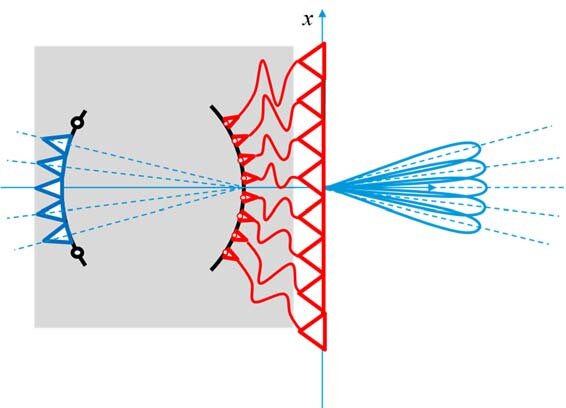Two-Dimensional and Three-Dimensional Discrete Constrained Lenses with Minimized Optical Aberrations
| 750 - Abstract: |
| The present invention relates to a beamforming network, which includes a three-dimensional discrete lens with front and back apertures. The solution provides the usual advantages shown by discrete lenses while, at the same time, permits to alleviate the limitation of high volume and weight with associated difficulty in terms of accommodation, and to increase the scanning performance because of the higher number of focii guaranteed. ESA is looking for partners who would be interested in getting a license and implementing this patent. |
Description:
This invention presents new discrete lens antennas and BFN with controllable front-to back-aperture ratio. The possibility to dimension the back of the discrete lens independently from the front aperture guarantees to the antenna designer a significant flexibility. Two dimensional discrete lens antennas exploiting this zooming effect have been already proposed. In this invention, three-dimensional architectures are mainly considered. Possible architectures which may benefit from this controllable zooming are:
1. An onboard multibeam satellite BFN and antenna based on discrete lenses designed with the back lens aperture smaller as compared to the front one in order to obtain a more compact solution with easier implementation (a reduction of a factor M in linear dimensions imply a reduction of a factor M3 in terms of volume!).
2. A second architecture, exploiting an opposite type of zooming, can be a BFN and antenna based on discrete lenses designed with the back larger as compared to the front in order to obtain an enlarged field of view with a reduced scanning on the back of the lens. The penalty associated to the larger dimensions of the back lens can be acceptable for a ground professional or gateway antenna considering the magnified field of view associated to this solution. This second type of zooming can be useful also for BFN and antennas to be installed onboard a satellite. As an example, on board satellites flying on MEO or LEO orbits, a single (or a limited number of) active antennas start to replace several passive antennas based on reflectors. As a consequence, the aperture available for installing the antenna can be significantly larger as compared to the minimum physical antenna aperture so allowing the installation of a lens antenna with a back aperture larger as compared to the radiating aperture.
Innovations and advantages:
Cost benefits can be expected in relation to:
- a reduction of mass and volume,
- a reduction & control of Optical Aberrations
- an extended field of view,
- a higher integration.
- New 3D lenses;
- On-board applications & Ground applications
Domain of application:
This solution has a large number of possible applications:
- multibeam generation of a high number of beams from a GEO, MEO, LEO satellite system
- multibeam generation of a high number of beams with a professional Ground Antenna with an extended field of view
IP Status
An International patent application (PCT) has been filed.



